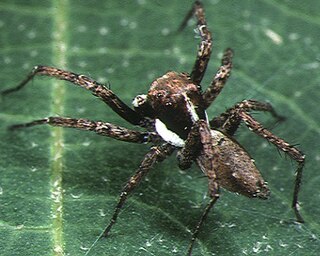
Jumping spiders are a group of spiders that constitute the family Salticidae. As of 2019, this family contained over 600 described genera and over 6,000 described species, making it the largest family of spiders at 13% of all species. Jumping spiders have some of the best vision among arthropods and use it in courtship, hunting, and navigation. Although they normally move unobtrusively and fairly slowly, most species are capable of very agile jumps, notably when hunting, but sometimes in response to sudden threats or crossing long gaps. Both their book lungs and tracheal system are well-developed, and they use both systems. Jumping spiders are generally recognized by their eye pattern. All jumping spiders have four pairs of eyes, with the anterior median pair being particularly large.

Portia is a genus of jumping spider that feeds on other spiders. They are remarkable for their intelligent hunting behaviour, which suggests that they are capable of learning and problem solving, traits normally attributed to much larger animals.

Araniella is a genus of orb-weaver spiders first described by R. V. Chamberlin & Wilton Ivie in 1942. The genus includes Araniella cucurbitina, the cucumber green spider.

Cytaea is a genus of spiders in the family Salticidae.

Neon is a spider genus of the jumping spider family, Salticidae. Its described species occur mostly in Eurasia, with some species found in North and South America. One species, N. convolutus, is also found in Algeria. Two species are known from Australia, N. australis and N. taylori. N. australis has palp morphology and fringing on its first pair of legs very similar to that seen in N. nojimai Ikeda 1995, from Japan. N. taylori is most similar in morphology to N. sumatranus from Indonesia and N. kovblyuki from the Crimea and elsewhere. The genus is common and widespread in litter throughout Australia, from the highlands of Tasmania through the hot, dry inland to the wet tropics and includes many undescribed species.

Phintella is a genus of jumping spiders that was first described by W. Bösenberg & Embrik Strand in 1906.
Xenocytaea is a genus of spiders in the family Salticidae (jumping spiders).
Cytaea carolinensis is a species of jumping spiders.
Cytaea koronivia is a species of jumping spiders.
Cytaea nausori is a species of jumping spiders.
Cytaea ponapensis is a species of jumping spider.
Cytaea rai is a species of jumping spider.
Cytaea vitiensis is a species of jumping spider.
Chinophrys wuae is a species of jumping spider, named after the collector Hai-Yin Wu. C. wuae is similar to Attulus penicillatus, and is only known from Taiwan.
Zebraplatys bulbus is a species of jumping spider.
Tauala elongata is a species of jumping spider.
Chinophrys taiwanensis is a species of jumping spiders.

Herbert Walter Levi was professor emeritus of zoology and curator of arachnology at the Museum of Comparative Zoology, Harvard University. He was born in Germany, and was educated there and at Leighton Park School, Reading in England. He then received his higher education at the University of Connecticut and the University of Wisconsin. Levi authored about 150 scientific papers on spiders and on biological conservation. He is the author of the popular Golden Guide Spiders and their Kin, with Lorna Rose Levi and Herbert Zim.
Papiamenta is a genus of Caribbean cellar spiders that was first described by B. A. Huber in 2000. As of June 2019 it contains only two species, found only on Curaçao: P. levii and P. savonet.
Barbara Maria Patoleta is a Polish arachnologist who specialises in the taxonomy, evolution and zoogeography of jumping spiders in the Pacific Islands.






